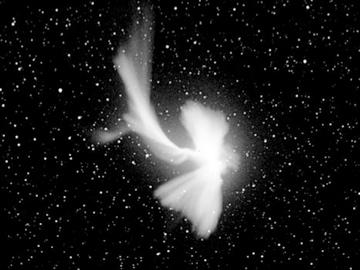Physics
The ROTSE Project at SMU
 Supernovae and gamma-ray bursts are catastrophic stellar explosions
which mark the final end of a star’s long struggle to balance the
crushing power of gravity against the outward radiant pressure
generated from their inner thermonuclear furnaces. The physics
involved in these events still has many unanswered questions,
including the true nature of the progenitors in what are termed
Type Ia supernovae. These are believed to be a large, luminous
red giant star orbited by a dead, superdense white dwarf companion.
Here the white dwarf steals matter from the giant and eventually crosses a
critical threshold, called the Chandrasekhar limit, where the white dwarf
can no longer support its weight and collapses. These supernovae now also
serve as a critical element in the cosmologist’s toolkit, having led to the
discovery and study of the accelerating expansion of the universe and
dark energy. Because the mass limit of white dwarf is fixed, these
supernovae theoretically provide a ‘standard candle’ allowing their
distances to be determined. The ROTSE effort has been focused on
studying these events to test these theories and to help provide
better constraints when using these events for cosmology. The SMU
group pursues studies of Type Ia supernovae, as well as core-collapse
supernovae that may provide another complementary test of cosmology.
Supernovae and gamma-ray bursts are catastrophic stellar explosions
which mark the final end of a star’s long struggle to balance the
crushing power of gravity against the outward radiant pressure
generated from their inner thermonuclear furnaces. The physics
involved in these events still has many unanswered questions,
including the true nature of the progenitors in what are termed
Type Ia supernovae. These are believed to be a large, luminous
red giant star orbited by a dead, superdense white dwarf companion.
Here the white dwarf steals matter from the giant and eventually crosses a
critical threshold, called the Chandrasekhar limit, where the white dwarf
can no longer support its weight and collapses. These supernovae now also
serve as a critical element in the cosmologist’s toolkit, having led to the
discovery and study of the accelerating expansion of the universe and
dark energy. Because the mass limit of white dwarf is fixed, these
supernovae theoretically provide a ‘standard candle’ allowing their
distances to be determined. The ROTSE effort has been focused on
studying these events to test these theories and to help provide
better constraints when using these events for cosmology. The SMU
group pursues studies of Type Ia supernovae, as well as core-collapse
supernovae that may provide another complementary test of cosmology.